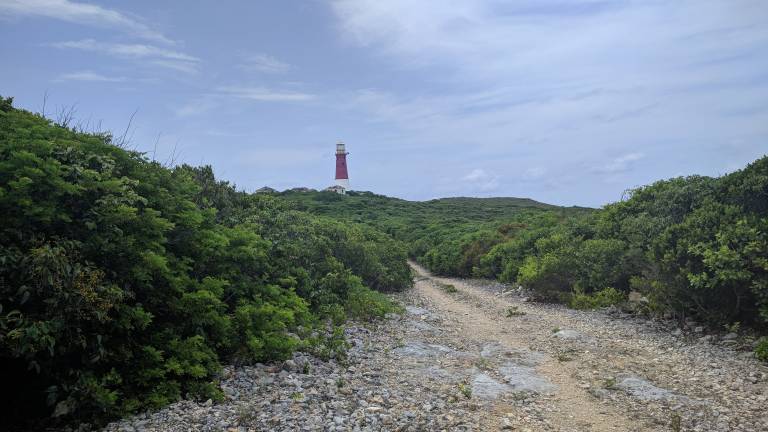Hole in the Wall Lighthouse: Finding Your Way

I had only been to Crossing Rock once and I didn't actually stop. It was on the way to Sandy Point, which is 50 miles south of Marsh Harbour and my co-worker Melinda had shown me the ambiguously marked entrance, and related a brief history of the community. All I had was a vague memory of the location, Google Maps and a guarantee that knowing myself I could get lost.
Still, I departed the office around 10:00 on a Monday morning, dressed in what I deemed to be comfortable enough — my most comfortable loafers and trousers — for a journey that I would later learn I had severely underestimated. Before I left Marsh Harbour, I filled my car with gas, as a drive from Marsh Harbour to Treasure Cay always took a toll on my tank; I didn't want to imagine what it would be like driving to the south without taking that extra precaution.
Having done extensive research before deciding I wanted to at least attempt to get close to the Hole in the Wall Lighthouse, I learned a few things. Firstly, unbeknownst to a lot of people, myself included at the time, there are three lighthouses in Abaco: Elbow Reef Lighthouse, the Old Lighthouse and the Hole in the Wall Lighthouse. The Hole in the Wall is located on the southern tip of Abaco and its name is derived from a geological formation, which I later came to learn about from Marcus, who explained that when the lighthouse was first built, there was a small opening in the land (a hole) that allowed boats to come through. However, Hurricane Floyd of 1999 cracked it and thirteen years later, in 2012, Hurricane Sandy broke it completely down to the point where, today, “the hole in the wall” no longer exists, but the name stuck.
It took me about 30 minutes to get to the entrance of Crossing Rock. Around the halfway mark, my GPS lost signal, and I lost access to Google Maps, so I was left to trust my memory. Luckily for me, Marcus called me every now and again to make sure I was on the right path. When I finally arrived, I was instructed to park my car and hop into the BNT’s truck and this is where the real adventure began. Marcus was fully ready for this journey, equipped with a small cooler filled with ice, water, OFF insect repellant and the truck – which would prove to be the real secret weapon. I quickly found out that the journey to the lighthouse requires a well-equipped truck (which is why we left my car), a tank full of gas, courage, lots of patience and a well-informed guide.
After ten minutes on the road, Marcus made a quick left turn onto a side road, which I learned about from my research, yet sorely underestimated. The beginning of the road that leads to the Hole in the Wall Lighthouse is lined with pine trees; it’s almost as if the pine trees are a big bear hug welcoming you to the other side. As the ride continues, the welcoming committee that were the pine trees slowly thins out, then disappears. When they disappear, your cell phone service disappears and it’s you, the wilderness and your thoughts. As we drive deeper into the wilderness, Marcus begins to explain to me the layout of the land that leads to the lighthouse. According to him, the bushes further up the trail were low coppice and because of the nature of the vegetation, the soil wasn’t soft enough to plant pine trees, which explains the absence of pine trees.

We drove until the road became impassable. What served as an unpaved path was now blocked by trees and rocks which made it impossible to drive through but easily passable by foot. At that moment, I realized that my comfortable gear was fraudulent and there was no way I would be able to make it to the lighthouse, climb the stairs and back without ripping my loafers. The truth was, I had come underprepared to truly hike to the lighthouse but even though lack of preparation prevented me from doing so, it was easy to see why even in its state of neglect, the lighthouse remains a beauty in south Abaco.
Like a solitary sentinel it stood, with no civilization in sight. The view from the bottom of the lighthouse was breathtaking, so it was easy to imagine what the panoramic view from the top would bring. Its structure tells a story of survival. Having endured many damaging hurricanes, it was still standing tall and strong. As imperfect an edifice it may be — its inner walls have a story that deserves to be understood and recognized.
